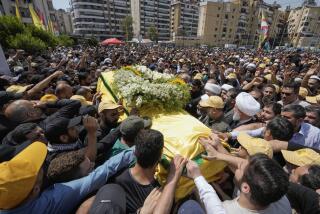Disentangling the Bombers’ Links
- Share via
The fortuitous discovery in New York of a plot to carry out suicide bombings on the city’s subways has set off a drama of investigation, intelligence work and interpretation in which contending parties will attempt to shape American perceptions and policy.
The key question is whether the would-be bombers were acting on their own or were part of a broader terrorist scheme with international connections.
Terrorism in recent years has become organizationally more fluid. In place of the readily identifiable terrorist formations of the 1970s and 1980s, terrorism in the 1990s is frequently the product of ad hoc conspiracies that grow out of vast but nebulous universes of anger and frustration. Sharing common views, often fueled by religious fervor, inspired by events, a handful of like-minded extremists will assemble to plan a single major act of violence. The conspiracies are small, lack formal hierarchy and have no organizational antecedents. They are an intelligence service’s nightmare, for they are virtually undiscoverable. Absent a lucky tip, their existence is revealed when the bomb goes off.
The 1993 World Trade Center bombing would seem to fall in this category, although some analysts remain convinced that foreign instigation and assistance were involved. We may learn more during the current trial of Ramzi Ahmed Yousef, one of the alleged masterminds of the attack.
It would be nice to learn that the Brooklyn subway plot, revealed Aug. 1, is also an isolated incident with no wider connections, although it is still disturbing that events in the Middle East have the power to produce the rage required for a suicide bombing in America.
The proximity of this plot to the July 30 bombing of the market in Jerusalem, the claim by one of those apprehended that he had been arrested in Israel as a suspected terrorist and initial statements reported in the press that one claimed membership in Hamas raise the specter of a more ambitious terrorist project.
This interpretation was fueled by leaks to the press from Palestinian sources--Yasser Arafat’s men--that the Brooklyn bombers were linked to a Jordanian faction of Hamas led by Mousa abu Marzouk. It is conceivable that the planned attack in Brooklyn might have been instigated by Marzouk in revenge for the two years he spent in jail here as an accused terrorist while American authorities debated whether to extradite him to Israel. Hamas militants threatened to attack Americans if Marzouk was sent to Israel, but Israel decided to drop its demands and instead the U.S. deported him to Jordan two months ago.
Exporting terrorism to American soil would indicate a fundamental shift in Hamas strategy--a determination to carry out here the same kind of horrific suicide bombings that we have seen in Israel. Moreover, it would indicate a serious intelligence failure. There are known to be Hamas supporters in the United States. The discovery by sheer luck of a terrorist cell in Brooklyn would indicate that there are Hamas terrorist operatives here completely unknown to the authorities.
But the Palestinian sources who point the finger at Hamas cannot be entirely trusted. The Hamas bombing in Jerusalem makes Arafat look impotent in preventing terrorism and obliges him to crack down on Hamas militants, which costs him support among dissatisfied Palestinians. It would therefore be convenient if Arafat could blame both the Jerusalem bombing and the Brooklyn conspiracy on a Hamas faction in Jordan led by the very man the United States once had in its custody.
Hamas leaders, not surprisingly, deny that they had anything to do with the two suspects in Brooklyn. They reassure us that while they will continue to blow up Israelis in Israel, they will not blow up Americans in the U.S. There are sound reasons why Hamas would not export terrorism to America. It could interfere with the financial support provided by Hamas supporters in America, cause trouble with the Jordanian authorities and provoke direct U.S. retaliation. Hamas therefore wants to convince us that the Brooklyn conspirators are unaffiliated renegades.
Whoever is responsible, a terrorist bombing in Israel or America instantly changes the way we perceive and depict the conflict in the Middle East. The carnage transforms Israel’s image from stubborn overlord to victim under siege. Sympathy becomes solidarity. Pressure on Israel for concessions to the Palestinians eases as U.S. Middle East policy becomes anti-terrorist policy.
Since, in this way, terrorism is “beneficial” to Israel, there are inevitably those in the Middle East, so long accustomed to being misled and manipulated, who will advance the theory that it is the vaunted Israeli intelligence services themselves that fabricated the Brooklyn conspiracy to frighten Americans.
Preposterous theories such as this, with attendant information, disinformation, allegations and denials, will seize the imagination as we attempt to solve what really happened in Brooklyn.
More to Read
Sign up for Essential California
The most important California stories and recommendations in your inbox every morning.
You may occasionally receive promotional content from the Los Angeles Times.










